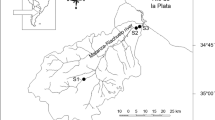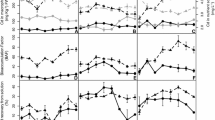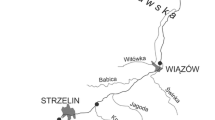Abstract
Aquatic macrophytes can absorb heavy metals either from sediments via the root system, from the water phase by leaves, or from both sources. In this study, cadmium accumulation and distribution in the aquatic plant Hydrilla verticillata were investigated, with a focus on the role of roots. Results showed that leaves of H. verticillata had a higher Cd concentration than roots when intact plants were grown in sediments and solutions containing Cd. Cadmium can significantly decrease the leaf chlorophyll content, and the leaves of intact plants with roots had lower chlorophyll contents than the leaves of detached ones without roots due to the transfer effect of roots. The majority of the Cd accumulated in leaves of H. verticillata was bound to the cell walls. When roots were submerged in a solution containing Cd, with shoots in a control solution without Cd, the Cd concentrations in leaves were considerably lower than in roots. In contrast, Cd was almost undetectable in roots when the shoots were submerged in a solution containing Cd, with roots in the control solution. Compared to the leaves and stems of detached shoots without roots, the concentrations of Cd were much higher in the leaves and stems of intact plants with roots. It is suggested that the roots of intact plants absorb Cd and transfer it to leaves and that more Cd is removed from the solution by intact plants.



Similar content being viewed by others
References
Agunbiade FO, Olu-Owolabi BI, Adebowale KO (2009) Phytoremediation potential of Eichornia crassipes in metal-contaminated coastal water. Bioresource Technol 100:4521–4526
Ahmad A, Ghufran R, Zularisam AW (2011) Phytosequestration of metals in selected plants growing on a contaminated Okhla Industrial Areas, Okhla, New Delhi, India. Water Air Soil Poll 217:255–266
Babel S, Kurniawan TA (2003) Low-cost adsorbents for heavy metals uptake from contaminated water: a review. J Hazard Mater B97:219–243
Baldantoni D, Alfani A, Tommasi PD, Bartoli G, Santo AVD (2004) Assessment of macro and microelement accumulation capability of two aquatic plants. Environ Pollut 130:149–156
Balen B, Tkalelc M, Sikic S, Tolic S, Cvjetko P, Pavica M, Vidakovic-Cifrek Z (2011) Biochemical responses of Lemna minor experimentally exposed to cadmium and zinc. Ecotoxicology 20(4):815–826
Baral SS, Das N, Chaudhury GR, Das SN (2009) A preliminary study on the adsorptive removal of Cr(VI) using seaweed, Hydrilla verticillata. J Hazard Mater 171:358–369
Bedouet L, Denys E, Courtois B, Courtois J (2006) Changes in esterified pectins during development in the flax stems and leaves. Carbohyd Polym 65:165–173
Brix H (1997) Do macrophytes play a role in constructed treatment wetlands? Water Sci Technol 35(5):11–17
Bunluesin S, Kruatrachue M, Pokethitiyook P, Upatham S, Lanza GR (2007) Batch and continuous packed column studies of cadmium biosorption by Hydrilla verticillata biomass. J Biosci Bioeng 103(6):509–513
Cardwell AJ, Hawker DW, Greenway M (2002) Metal accumulation in aquatic macrophytes from southeast Queensland, Australia. Chemosphere 48:653–663
Demim S, Drouiche N, Aouabed A, Benayad T, Dendene-Badache O, Semsari S (2013) Cadmium and nickel: assessment of the physiological effects and heavy metal removal using a response surface approach by L. gibba. Ecol Eng 61:426–435
Deng G, Li M, Li H, Yin LY, Li W (2014) Exposure to cadmium causes declines in growth and photosynthesis in the endangered aquatic fern (Ceratopteris pteridoides). Aquat Bot 112:23–32
Dhir B, Sharmila P, Saradhi PP, Nasim SA (2009) Physiological and antioxidant responses of Salvinia natans exposed to chromium-rich wastewater. Ecotox Environ Safe 72:1790–1797
Ekmekci Y, Tanyolac D, Ayhan B (2008) Effects of cadmium on antioxidant enzyme and photosynthetic activities in leaves of two maize cultivars. J Plant Physiol 165(6):600–611
Fritioff A, Greger M (2006) Uptake and distribution of Zn, Cu, Cd, and Pb in an aquatic plant Potamogeton natans. Chemosphere 63:220–227
Gabbrielli R, Pandfini T, Palandri MR (1990) Comparison of two serpentinite species with different nickel tolerance strategies. Plant Soil 122:271–277
Gallego SM, Pena LB, Barcia RA, Azpilicueta CE, Iannone MF, Rosales EP, Zawoznik MS, Groppa MD, Benavides MP (2012) Unravelling cadmium toxicity and tolerance in plants: insight into regulatory mechanisms. Environ Exp Bot 83:33–46
Greger M, Lindberg S (1987) Effects of Cd2+ and EDTA on young sugar-beets (Beta vulgaris).2.Net uptake and distribution of Mg2+, Ca2+ and Fe2+/Fe3+. Physiol Plantarum 69(1):81–86
Gupta M, Chandra P (1994) Lead accumulation and toxicity in Vallisneria siralis (L) and Hydrilla verticillata (LF) Royle. J Environ Sci Heal A 29(3):503–516
Hall JL (2002) Cellular mechanisms for heavy metal detoxification and tolerance. J Exp Bot 53(366):1–11
Hoagland DR, Arnon DI (1950) The water-culture method for growing plants without soil. Calif Agr Exp Sta Circ 347
Hozhina EI, Khramov AA, Gerasimov PA, Kumaekov AA (2001) Uptake of heavy metals, arsenic, and antimony by aquatic plants in the vicinity of ore mining and processing industries. J Geochem Explor 74:153–162
Huang GY, Wang YS (2010) Physiological and biochemical responses in the leaves of two mangrove plant seedlings (Kandelia candel and Bruguiera gymnorrhiza) exposed to multiple heavy metals. J Hazard Mater 182:848–854
Jackson LJ (1998) Paradigms of metal accumulation in rooted aquatic vascular plants. Sci Total Environ 219:223–231
Javed MT, Greger M (2011) Cadmium triggers Elodea canadensis to change the surrounding water pH and thereby Cd uptake. Int J Phytorem 13:95–106
Javed MT, Lindberg S, Greger M (2014a) Cadmium uptake in Elodea canadensis leaves and its interference with extra- and intra- cellular pH. Plant Biol 16(3):615–621
Javed MT, Lindberg S, Greger M (2014b) Cellular proton dynamics in Elodea canadensis leaves induced by cadmium. Plant Physiol Biochem 77:15–22
Kirkham MB (2006) Cadmium in plants on polluted soils: Effects of soil factors, hyperaccumulation, and amendments. Geoderma 137:19–32
Kumari M, Tripathi BD (2015) Efficiency of Phragmites australis and Typha latifolia for heavy metal removal from wastewater. Ecotox Environ Safe 112:80–86
Lewander M, Greger M, Kautsky L, Szarek E (1996) Macrophytes as indicators of bioavailable Cd, Pb and Zn flow in the river Przemsza, Katowice Region. Appl Geochem 11:169–173
Lichtenthaler HK, Wellburn AR (1983) Determinations of total carotenoids and chlorophylls a and b of leaf extracts in different solvents. Biochem Soc T 11:591–592
Liu CP, Shen ZG, Li XD (2007a) Accumulation and detoxification of cadmium in Brassica pekinensis and B. chinesnsis. Biol Plantarum 51:116–120
Liu YG, Wang X, Zeng GM, Qu D, Gu JJ, Zhou M, Chai LY (2007b) Cadmium-induced oxidative stress and response of the ascorbate–glutathione cycle in Bechmeria nivea (L.) Gaud. Chemosphere 69:99–107
Lou LQ, Shen ZG, Li XD (2004) The copper tolerance mechanisms of Elsholtzia haichowensis, a plant from copper-enriched soils. Environ Exp Bot 51:111–120
Lux A, Martinka M, Vaculík M, White PJ (2011) Root responses to cadmium in the rhizosphere: a review. J Exp Bot 62:21–37
Marchand L, Mench M, Jacob DL, Otte ML (2010) Metal and metalloid removal in constructed wetlands, with emphasis on the importance of plants and standardized measurements: a review. Environ Pollut 158:3447–3461
Megateli S, Semsari S, Couderchet M (2009) Toxicity and removal of heavy metals (cadmium, copper, and zinc) by Lemna gibba. Ecotox Environ Safe 72:1774–1780
Miretzky P, Saralegui A, Cirelli AF (2004) Aquatic macrophytes potential for the simultaneous removal of heavy metals (Buenos Aires, Argentina). Chemosphere 57:997–1005
Mishra VK, Tripathi BD (2008) Concurrent removal and accumulation of heavy metals by the three aquatic macrophytes. Bioresource Technol 99:7091–7097
Mishra VK, Upadhyaya AR, Pandey SK, Tripathi BD (2008) Heavy metal pollution induced due to coal mining effluent on surrounding aquatic ecosystem and its management through naturally occurring aquatic macrophytes. Bioresource Technol 99:930–936
Mobin M, Khan NA (2007) Photosynthetic activity, pigment composition and antioxidative response of two mustard (Brassica juncea) cultivars differing in photosynthetic capacity subjected to cadmium stress. J Plant Physiol 164:601–610
Morsch VM, Schetinger MRC, Martins AF, Rocha JBT (2002) Effects of cadmium, lead, mercury and zinc on delta-aminolevulinic acid dehydratase activity from radish leaves. Biol Plantarum 45(1):85–89
Nigam S, Gopal K, Vankar PS (2013) Biosorption of arsenic in drinking water by submerged plant: Hydrilla verticilata. Environ Sci Pollut R 20:4000–4008
Peng KJ, Luo CL, Lou LQ, Li XD, Shen ZG (2008) Bioaccumulation of heavy metals by the aquatic plants Potamogeton pectinatus L. and Potamogeton malaianus Miq. and their potential use for contamination indicators and in wastewater treatment. Sci Total Environ 392:22–29
Polechońska L, Klink A (2014) Trace metal bioindication and phytoremediation potentialities of Phalaris arundinacea L. (reed canary grass). J Geochem Explor 146:27–33
Qian HF, Li JJ, Sun LW, Chen W, Sheng DG, Liu WP, Fu ZW (2009) Combined effect of copper and cadmium on Chlorella vulgaris growth and photosynthesis-related gene transcription. Aquat Toxicol 94:56–61
Rahman MA, Hasegawa H (2011) Aquatic arsenic: phytoremediation using floating macrophytes. Chemosphere 83:633–646
Rai AK, Rai V (2003) Effect of NaCl on growth, nitrate uptake and reduction and nitrogenase activity of Azolla pinnata-Anabaena azollae. Plant Sci 164:61–69
Salt DE, Smith RD, Raskin I (1998) Phytoremediation. Annu Rev Plant Biol 49:643–668
Sanità di Toppi L, Gabbrielli R (1999) Response to cadmium in higher plants. Environ Exp Bot 41:105–130
Somashekaraiah BV, Padmaja K, Prasad ARK (1992) Phytotoxicity of cadmium ions on germinating seedlings of mung bean (Phaseolus vulgaris) involvement of lipid peroxides in chlorophyll degradation. Physiol Plantarum 85(1):85–89
Sood A, Uniyal PL, Prasanna R, Ahluwalia AS (2012) Phytoremediation Potential of Aquatic Macrophyte, Azolla. Ambio 41:122–137
Stobart AK, Griffiths WT, Ameenbukhari I, Sherwood RP (1985) The effect of Cd2+ on the biosynthesis of chlorophyll in leaves of barley. Physiol Plantarum 63(3):293–298
Sun JY, Cui J, Luo CL, Gao L, Chen YH, Shen ZG (2013) Contribution of cell walls, nonprotein thiols, and organic acids to cadmium resistance in two cabbage varieties. Arch Environ Con Tox 64:243–252
Uraguchi S, Kiyono M, Sakamoto T, Watanabe I, Kuno K (2009) Contributions of apoplasmic cadmium accumulation, antioxidative enzymes and induction of phytochelatins in cadmium tolerance of the cadmium-accumulating cultivar of black oat (Avena strigosa Schreb). Planta 230:267–276
Van Donk E, Van de Bund WJ (2002) Impact of submerged macrophytes including charophytes on phyto- and zooplankton communities: allelopathy versus other mechanisms. Aquat Bot 72:261–274
Weigel HJ, Jager H (1980) Subcellular distribution and chemical form of cadmium in bean plants. Plant Physiol 65:480–482
Wu AH, Jia J, Luan SJ (2011) Amphiphilic PMMA/PEI core-shell nanoparticles as polymeric adsorbents to remove heavy metal pollutants. Colloid Surface A 384:180–185
Wu ZC, Zhao XH, Sun XC, Tan QL, Tang YF, Nie ZJ, Hu CX (2015) Xylem transport and gene expression play decisive roles in cadmium accumulation in shoots of two oilseed rape cultivars (Brassica napus). Chemosphere 119:1217–1223
Xu QS, Chu WY, Qiu H, Fu YY, Cai SJ, Sha S (2013a) Responses of Hydrilla verticillata (L.f.) Royle to zinc: in situ localization, subcellular distribution and physiological and ultrastructural modifications. Plant Physiol Bioch 69:43–48
Xu QS, Qiu H, Chu WY, Fu YY, Cai SJ, Min HL, Sha S (2013b) Copper ultr astructural localization, subcellular distribution, and phytotoxicity in Hydrilla verticillata (L.f.) Royle. Environ Sci Pollut R 20:8672–8679
Xue PY, Yan CZ (2011) Arsenic accumulation and translocation in the submerged macrophyte Hydrilla verticillata (L.f.) Royle. Chemosphere 85:1176–1181
Xue PY, Li GX, Liu WJ, Yan CZ (2010) Copper uptake and translocation in a submerged aquatic plant Hydrilla verticillata (L.f.) Royle. Chemosphere 81:1098–1103
Zandleven J, Sorensen SO, Harholt J, Beldman G, Schols HA, Scheller HV, Voragen AJ (2007) Xylogalacturonan exists in cell walls from various tissues of Arabidopsis thaliana. Phytochemistry 68:1219–1226
Author information
Authors and Affiliations
Corresponding author
Additional information
Responsible editor: Elena Maestri
Rights and permissions
About this article
Cite this article
He, Y., Rui, H., Chen, C. et al. The role of roots in the accumulation and removal of cadmium by the aquatic plant Hydrilla verticillata . Environ Sci Pollut Res 23, 13308–13316 (2016). https://doi.org/10.1007/s11356-016-6505-8
Received:
Accepted:
Published:
Issue Date:
DOI: https://doi.org/10.1007/s11356-016-6505-8




